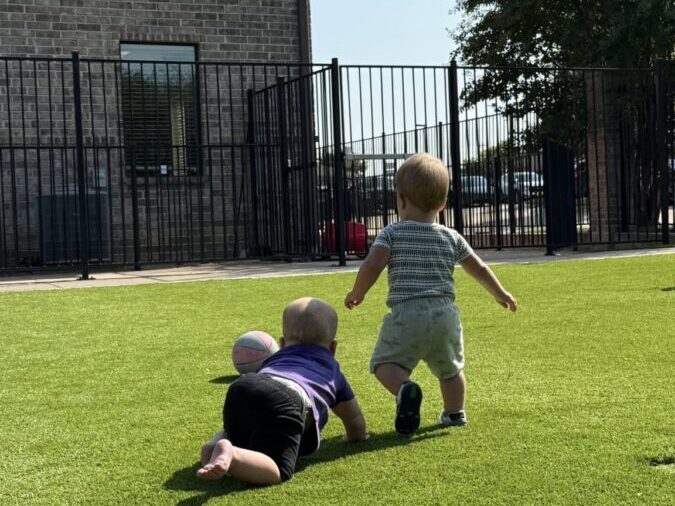Infants in Daycare: Why Your Baby’s First Classroom Shapes Their Future
The moment you drop off your infant at daycare for the first time, something fundamental shifts. You’re not just leaving your baby with caregivers—you’re entrusting them with the foundation of your child’s emotional, social, and cognitive development. Research shows that 90% of brain development occurs before age five, with the most rapid growth happening during infancy. At Castle Creek Christian Academy, we understand that creating a truly nurturing environment for infants in daycare isn’t just about meeting basic needs; it’s about cultivating the conditions where tiny humans can thrive during their most formative months.
The question keeping most parents awake isn’t whether their baby will be fed or changed on time. It’s whether their child will feel loved, secure, and emotionally connected when they can’t be there themselves. That concern isn’t just parental anxiety—it’s grounded in decades of developmental psychology that confirms what your instincts already tell you: how infants experience care in their earliest months creates neural pathways that influence how they’ll navigate relationships, manage stress, and approach learning for the rest of their lives.

The Science Behind Secure Attachments in Early Care
When we talk about a nurturing environment for infants in daycare, we’re really talking about attachment theory in action. Developed by psychologist John Bowlby and expanded by Mary Ainsworth, attachment theory demonstrates that babies need consistent, responsive caregiving to develop what researchers call “secure attachment.” This isn’t some abstract concept—it’s the difference between a child who explores their world with confidence and one who feels anxious about their safety.
Secure attachment forms when caregivers consistently respond to an infant’s needs with warmth and attentiveness. When your seven-month-old reaches out and someone reaches back every time, when they cry and someone comes to comfort them, when they smile and receive genuine delight in return—these repeated interactions literally wire their developing brain. Studies using neuroimaging have shown that nurturing care increases activity in areas of the brain associated with emotional regulation and social bonding.
The ratio of caregivers to infants matters tremendously here. Quality infant care typically maintains ratios of one caregiver for every three to four babies, allowing for the individualized attention that makes responsive caregiving possible. When caregivers aren’t overwhelmed by numbers, they can notice the subtle cues that tell them what each baby needs—whether that’s comfort, stimulation, or simply a familiar face during an overwhelming moment.
Creating Environments Where Infant Development Flourishes
A nurturing environment for infants in daycare extends beyond the caregiver’s arms to encompass the entire physical and emotional space. The sensory experience of infant care settings profoundly impacts development. Soft lighting rather than harsh fluorescents, gentle background sounds instead of chaotic noise, and comfortable temperatures all contribute to an environment where infants feel calm enough to learn and grow.
The physical layout should support what developmental experts call “serve and return” interactions—those back-and-forth exchanges between baby and caregiver that build neural connections. Floor time on safe, clean surfaces allows infants to practice motor skills while maintaining eye contact with caregivers. Cozy corners for feeding and rocking provide intimacy during vulnerable moments. Age-appropriate toys that encourage exploration without overwhelming developing senses give infants agency in their own learning.
Consistency in caregiving staff creates another layer of security. When infants see the same loving faces day after day, they develop trust more readily. This stability allows them to form those crucial secure attachments and provides the emotional foundation they need to eventually separate from primary caregivers without distress. The nurturing environment isn’t just about the space—it’s about the predictable, loving people who inhabit it.
The Ripple Effects of Quality Infant Care
The benefits of a nurturing environment for infants in daycare don’t stop when your child moves to the toddler room. Research tracking children longitudinally shows that infants who receive high-quality care demonstrate better language development, stronger problem-solving skills, and more positive peer relationships throughout early childhood. Perhaps more importantly, they show greater emotional resilience and lower levels of stress hormones even years later.
These children tend to approach new situations with curiosity rather than fear because their earliest experiences taught them the world is fundamentally safe. They regulate emotions more effectively because their caregivers modeled co-regulation—staying calm and present while helping them work through big feelings. They form friendships more easily because they learned about reciprocal relationships during those countless serve-and-return interactions in infancy.
For working parents navigating the complex emotions of returning to work, understanding these long-term benefits can provide genuine reassurance. Choosing quality infant care isn’t a compromise—it’s an investment in your child’s developmental trajectory. The nurturing environment you select becomes an extension of your own parenting, complementing the love and care you provide at home.
What to Look for When Choosing Infant Care
Finding a truly nurturing environment for infants in daycare requires looking beyond cheerful wall decorations and promotional materials. Start by observing how caregivers interact with babies during your visit. Do they get down on the floor at the infant’s level? Do they narrate their actions and respond to babbling as though it’s meaningful conversation? Do they seem genuinely delighted by the children in their care, or merely patient?
Ask about caregiver training in infant development and attachment. Quality programs invest in ongoing professional development that helps staff understand the “why” behind responsive caregiving practices. Inquire about continuity of care policies—how long do caregivers typically stay in the infant room, and what happens when someone leaves? The answers reveal whether the program prioritizes the stable relationships that secure attachment requires.
Pay attention to the pace of the environment. Nurturing infant care doesn’t rush. There’s time for unhurried feeding, gentle diaper changes accompanied by conversation, and plenty of unstructured moments when babies can simply be present with caring adults. If the environment feels frantic or caregivers seem hurried, that stress transfers to the infants in their care.
Building Partnership Between Home and Daycare
The most nurturing environment for infants in daycare recognizes that parents remain the primary attachment figures and most important people in their baby’s life. Quality programs create genuine partnerships with families, sharing detailed information about your child’s day while respecting your knowledge of your own baby. When caregivers ask about your infant’s preferences, routines, and personality, they’re acknowledging that continuity between home and care settings supports secure attachment.
Regular communication helps caregivers respond to your baby as an individual rather than just another infant in the room. Maybe your daughter settles more easily with a specific song, or your son needs extra comfort during transitions. These details allow caregivers to provide personalized care that feels consistent with what happens at home. The partnership between parents and caregivers creates a web of responsive relationships that supports infant development from all angles.
This collaboration also supports your own adjustment to returning to work. When you trust that your baby’s caregivers understand and meet their needs with the same attentiveness you would provide, you can focus on your responsibilities knowing your child is truly flourishing. That peace of mind benefits everyone—you’re more present at work, less anxious at home, and more able to enjoy the precious time you have with your infant. Contact us today to learn more about our programs!
